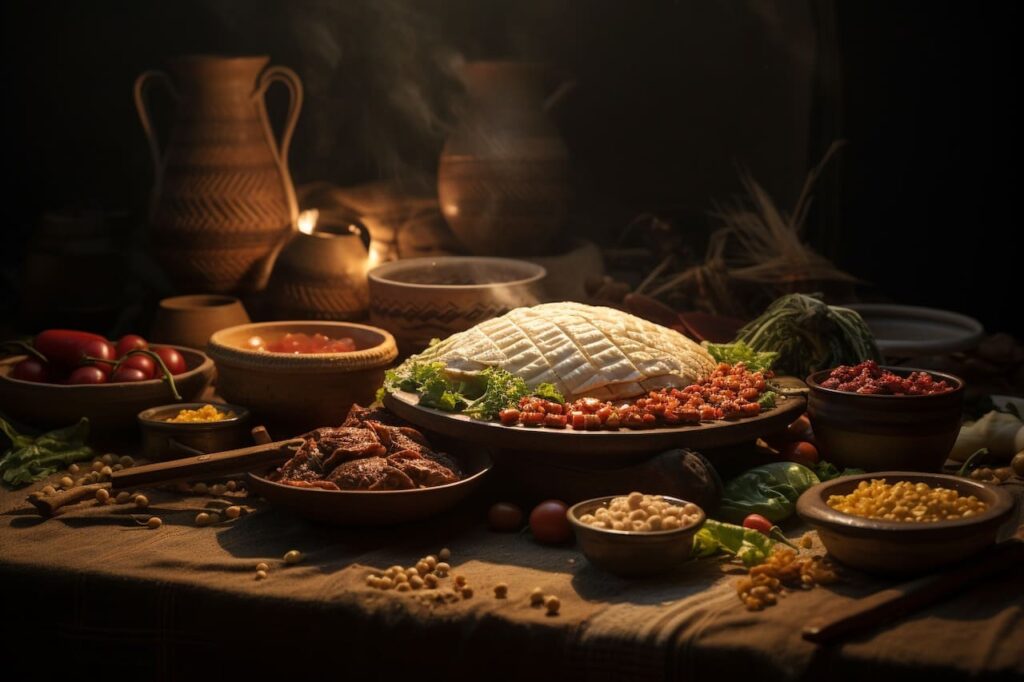Indigenous cuisine is a celebration of the flavors, ingredients, and cooking techniques that have been passed down from generation to generation. From the North American plains to the African savannas, people of all cultures have their own unique stories and recipes that are deeply tied to their heritage. This type of cuisine is a reflection of a people’s identity and history, and exploring it can be an incredibly rewarding experience.
Uncovering Indigenous Cuisine
For centuries, indigenous people have been sharing and celebrating their traditional cuisine. From barbecue to tacos, cornbread to bannock, the recipes are as diverse as the cultures they come from. As more and more people explore and embrace traditional ingredients, dishes, and techniques, the understanding of indigenous cuisine continues to expand.
One of the ways we can uncover more about this type of cuisine is by looking at the ingredients used. For example, in Native American cuisine, you’ll find staples like corn, squash, beans, and wild rice. In African cooking, you’ll find ingredients like millet, sorghum, and cassava. And in Australian Aboriginal cuisine, you’ll find ingredients like kangaroo, crocodile, and emu.
Ingredients, however, don’t tell the whole story. Traditional methods of cooking and preparation can be just as important. For example, in Native American cuisine, there are dishes like frybread and pemmican that use ingredients like lard and tallow in their recipes. In African cooking, you’ll find dishes like injera, which is a spongy flatbread made with teff flour. And in Australian Aboriginal cuisine, you’ll find dishes like witchetty grubs, which are roasted over the fire and eaten like popcorn.
Exploring Tastes Around the World
As you explore indigenous cuisine, you’ll start to notice similarities and differences in the way food is prepared and served. In Central and South American cuisines, you’ll find dishes like tacos and tamales that use corn as the main ingredient. In the Caribbean, you’ll find dishes like jerk chicken and curried goat that use a variety of spices and herbs. And in Oceania, you’ll find dishes like lomi salmon (raw fish marinated in lemon and chili) and poi (a type of mashed taro root).
Each culture has its own unique flavors, ingredients, and techniques. By exploring these differences, you can start to build an appreciation for the variety of indigenous cuisines around the world.
Appreciating Unique Flavors
When you start to explore indigenous cuisine, you’ll find that each culture has its own unique flavors and ingredients. For example, in Native American cuisine, you’ll find dishes that use ingredients like cranberries, huckleberries, wild greens, and wild rice. In African cooking, you’ll find dishes that use ingredients like okra, plantains, and yams. And in Australian Aboriginal cuisine, you’ll find dishes that use ingredients like kangaroo, emu, and bush tomato.
To fully appreciate the unique flavors of indigenous cuisine, it’s important to explore the ingredients and cooking techniques used in each culture. By trying different dishes and experimenting with different ingredients, you can begin to understand the flavors and techniques used in different parts of the world.
A Journey of Food and Culture
Exploring indigenous cuisine is more than just a culinary experience; it’s a journey of food and culture. When you explore the recipes, ingredients, and techniques used by different cultures, you’re not just learning about the food, you’re exploring the history, culture, and identity of a people.
By exploring indigenous cuisine, you’re not only understanding a culture’s relationship to food, but you’re also gaining an appreciation for the history and traditions that have been passed down for centuries.
Reveling in Authenticity
When it comes to indigenous cuisine, authenticity is key. While it’s always important to be respectful of the culture and its traditions, it’s also important to try and make dishes as close to the original recipe as possible.
When exploring indigenous cuisine, try to find recipes that are traditional to the culture and use ingredients that are native to the region. This will give you a better understanding of the cuisine and help you appreciate the flavors and techniques used in different cultures.
Celebrating Indigenous Cuisine
Indigenous cuisine is a celebration of flavors, ingredients, and cooking techniques that have been passed down from generation to generation. From the North American plains to the African savannas, people of all cultures have their own unique stories and recipes that are deeply tied to their heritage.
Exploring indigenous cuisine is not only an adventure of flavors and ingredients, but also a journey of culture and history. By embracing and celebrating traditional recipes and ingredients, we can gain a better appreciation for the diversity of indigenous cuisine around the world.
Indigenous cuisine is a celebration of the people, cultures, and flavors that make up our world. By exploring and embracing different cuisines, we can gain a better understanding of the history and traditions of different cultures and celebrate the unique flavors of indigenous cuisine.
Conclusion
Indigenous cuisine is an exploration of culture and history that can be both rewarding and delicious. From North American frybread to African injera, the flavors and ingredients used in traditional recipes reflect the stories and traditions of each culture. By learning about indigenous ingredients, dishes, and techniques, we can gain a better appreciation for the diversity of cuisine around the world.
Whether it’s exploring new flavors or revisiting old favorites, celebrating indigenous cuisine is a journey of food and culture that can bring us closer to our heritage and to each other.
